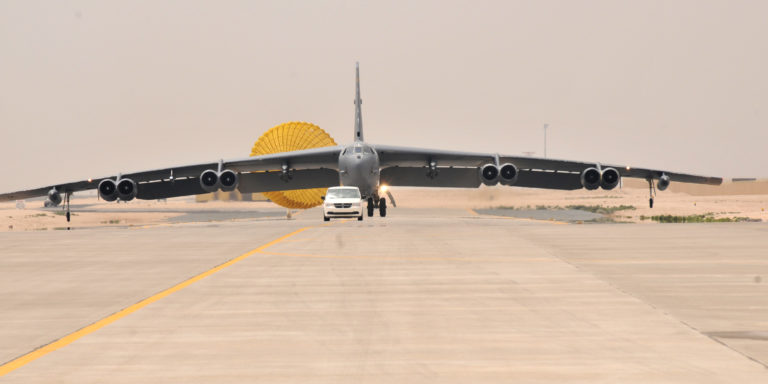INTELBRIEF
December 15, 2020
IntelBrief: U.S. Show of Force in the Gulf Intended to Send Message to Iran

Bottom Line Up Front
- Two recent overflights of the Persian Gulf by U.S. B-52 heavy bombers were intended to reinforce deterrence against Iran.
- The show of force is an alternative to striking Iran’s nuclear facilities, which Israeli Prime Minister Netanyahu reportedly urged President Trump to consider.
- Iran is unlikely to respond immediately to any U.S. or Israeli action as it awaits the inauguration of the Biden administration.
- The U.S. overflights heighten the potential for miscalculation, such as a potential response from Iran’s Russian-made S-300 air defense systems.
On December 10, and for the second time in two months, two U.S. B-52 heavy bombers flew roundtrip from their U.S. bases to conduct an overflight of the Persian Gulf. and were joined by aircraft from several U.S. allies in the region including Saudi Arabia, Bahrain, and Qatar. This second mission came at a time of high tensions between Iran and the outgoing US administration of President Trump, and very soon after the Israeli operation that killed the chief of Iran’s nuclear weapons research program, Mohsen Fakhrizadeh, in late November. Reports that Iran was instigating proxies in Iraq to attack U.S. forces and personnel appear to have led to the December mission, coinciding with reports that – reports that led the American Embassy in Baghdad, a frequent target of Iran-backed militias, to reduce its staff. Both U.S. overflights also occurred during a period of significant drawdown of U.S forces in Iraq and Afghanistan. The missions were intended to send a message to Tehran that it will pay a heavy price for retaliating for the Fakhrizadeh killing or any major attacks in Iraq or elsewhere, taking advantage of the U.S military drawdowns.
Iran’s nuclear weapons program has been virtually inactive for nearly twenty years. Nonetheless, Iran has continued to expand its civilian nuclear program as a response to the Trump administration’s abrogation of the 2015 multilateral Iran nuclear agreement. The expanded Iranian nuclear activity prompted President Trump to contemplate military strikes against Iran’s nuclear facilities, in light of the possibility Iran could enrich uranium to 20% purity, within reach of nuclear weapons grade. He has reportedly been urged to take such action by Israeli Prime Minister Binyamin Netanyahu, a close Trump ally who shares his hard line on Iran. Both Trump and Netanyahu oppose the Biden administration’s intended return to nuclear negotiations with Iran and an easing of U.S. sanctions pressure. Whereas it is widely believed Netanyahu ordered the Fakhrizadeh assassination, President Trump apparently has favored the middle ground—authorizing the B-52 overflights which did not actually enter Iranian airspace and vowed to retain the sanctions on Iran until the Biden administration takes office on January 20, 2021.
Iranian leaders are eagerly awaiting the departure of President Trump and presumably an end to the ‘maximum pressure’ strategy that has significantly harmed Iran’s economy. Anticipating that the incoming Biden administration will move forward on its plan to return the United States to the nuclear agreement, the leaders in Tehran are unlikely to respond directly or immediately to any U.S. or Israeli provocations at this time. Doing so risks not only direct conflict with the United States, but also creates additional political pressure on President-elect Biden’s team to forego plans to engage diplomatically with Iran.
Nonetheless, the U.S. bomber overflights carry a potential for miscalculation and unwanted U.S.-Iran conflict in the final weeks of the Trump administration. Iran has developed a robust air defense system centered on the Russian-made S-300 system that was delivered in 2016, after Iran agreed to the multilateral nuclear deal. That air defense system reportedly has been configured to protect against a strike on Iran’s nuclear facilities, which would be the main targets of any U.S. or Israeli air strikes, and Iran’s air defense units are primed to defend them. The United States and Iran have both miscalculated in the past, causing two mass-casualty events. In January 2020, Iran erroneously shot down a Ukrainian passenger jet after its air defense units mistook it for a military aircraft which they believed was retaliating for Iran’s missile strikes on U.S. forces in Iraq. Prior to that, in July 1988, the U.S. Navy erroneously shot down an Iranian passenger Airbus over the Gulf, perceiving the flight as an attacking Iranian combat aircraft. Although neither Iran nor the Trump administration appears to seek direct engagement, the potential for conflict has increased toward the conclusion of President Trump’s administration.